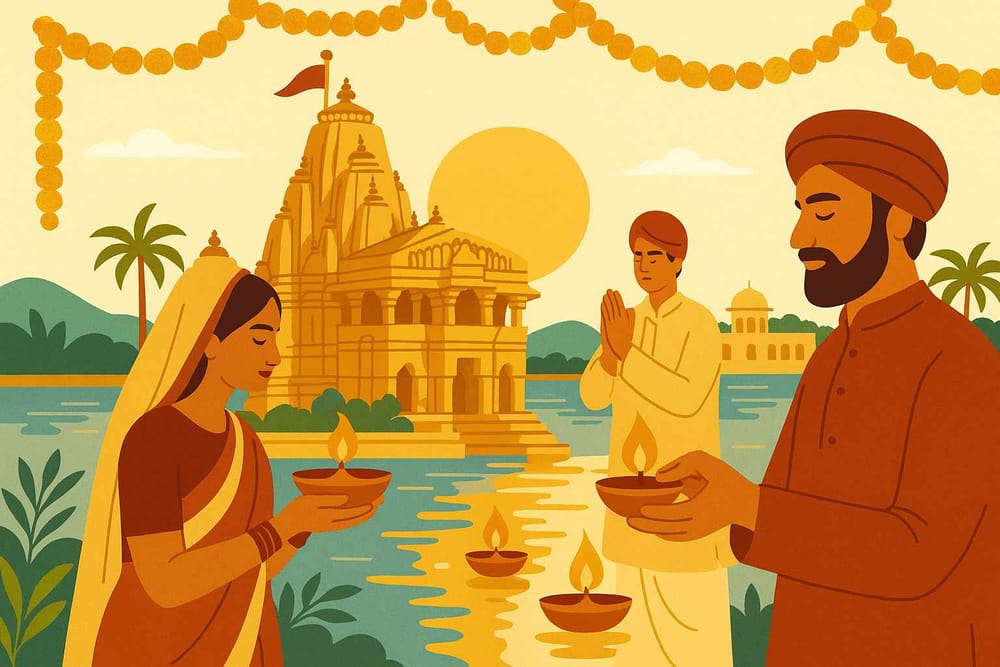
Connecting with Divinity in Udaipur: Your Guide to Temples, Rituals, and Local Beliefs
Udaipur, the 'City of Lakes,' embodies a beautiful blend of spirituality and nature. Its temples aren't just structures; they're living testaments to faith and devotion, deeply woven into the city's cultural fabric. Let's delve into the spiritual customs and rituals that make Udaipur's temples so special.
Temple Etiquette in Udaipur: A Guide to Respectful Visits
When you step into Udaipur's temples, embracing local customs shows reverence for the sacred space. These simple practices enrich your spiritual experience:
- Dress Modestly: Traditional attire like sarees or kurtas is ideal. This respects the spiritual atmosphere of the temple.
- Remove Footwear: Shoes are left outside as a mark of respect, maintaining the purity of the sacred ground.
- Avoid Leather: Many temples discourage leather items like belts or wallets. Consider leaving them outside.
- Respect Gender-Specific Areas: Some areas might be designated for men or women, depending on the deity.
- Use Your Right Hand: When offering flowers or donations, using the right hand is customary.
- Maintain Silence: Keep conversations low to preserve the tranquil ambiance.
- Photography Rules: Always check if photography is permitted before taking pictures.
- Temple Timings: Most temples open at sunrise and close around sunset. Plan your visit accordingly.
The Heart of Udaipur's Spirituality: Priests and Pandits
Priests are vital to Udaipur's spiritual landscape. Their role extends beyond rituals:
- Puja Facilitators: They conduct daily aartis and special ceremonies during festivals or important life events.
- Temple Historians: They are often keepers of the temple’s history and legends, sharing stories with devotees.
- Spiritual Guides: They offer guidance on various matters, from astrology to auspicious dates, rooted in tradition.
- Chanting Mantras: They invoke divine energies through Sanskrit verses during prayers.
- Temple Guardians: They oversee donations, cleanliness, and temple logistics.
For insights into the temples of Udaipur and their unique rituals, I recommend exploring reliable online resources and travel guides. They can provide you with the most current information and help you plan a spiritually fulfilling trip.
About Bhaktilipi.in: Your Gateway to Devotion
Bhaktilipi.in is a digital sanctuary for sacred texts, devotional stories, and poems. We offer timeless literature in original languages and translations, curated for the modern reader. Our content is rooted in tradition, inspiring devotion in today’s spiritual seekers. Explore stories that evoke bhakti and reflect on teachings that guide your spiritual journey. Whether you’re a beginner or a seasoned seeker, Bhaktilipi.in provides knowledge and inspiration for your path. Stay updated with new posts and features by subscribing to our newsletter. Follow us on Facebook, Instagram, and YouTube for more devotional content.
Udaipur's Spiritual Heartbeat
Udaipur's temples and rituals are more than just practices; they are gateways to timeless traditions. Whether you're at the Jagdish Temple, witnessing the serene aarti at Lake Pichola, or finding solace in smaller shrines, each experience resonates with devotion. As you journey through these sacred spaces, embrace the stories, rituals, and unwavering faith. Carry this spiritual energy with you, letting it inspire balance and gratitude.
Common Questions About Udaipur's Temples
Temple Etiquette: Dress modestly, remove footwear, and wash your hands before interacting with idols or offerings. Observing others or asking the priest for guidance is always helpful.
Participation in Rituals: Most temples welcome everyone, but some rituals may have specific guidelines. It's best to inquire at the temple.
Role of Priests: Priests guide devotees in rituals, prayers, and spiritual practices. They also chant mantras and oversee ceremonies.
Common Chants: You’ll often hear chants like “Om Namah Shivaya” or “Jai Shri Krishna,” which are central to many pujas.
Understanding Mantras: Priests are usually happy to explain the meaning of mantras. Some temples even hold sessions on their significance.
Best Times to Visit: Morning and evening aarti times offer a serene atmosphere for experiencing rituals.
Offerings: Bringing offerings like flowers, incense, or fruits is a respectful gesture, though not mandatory.
Connecting with Spirituality: Participate in rituals, meditate, listen to chants, and appreciate the temple's architecture to deepen your spiritual experience.
If you'd like to bring some of Udaipur's divine energy into your home, consider adding authentic puja items to your personal sacred space. Many online platforms now offer traditional, handcrafted items to enhance your worship.
May your Udaipur journey deepen your spiritual connection and bring blessings into your life.
A passionate group of people dedicated to preserving India's knowledge of Dharma, Karma, and Bhakti for ourselves and the world 🙏.
